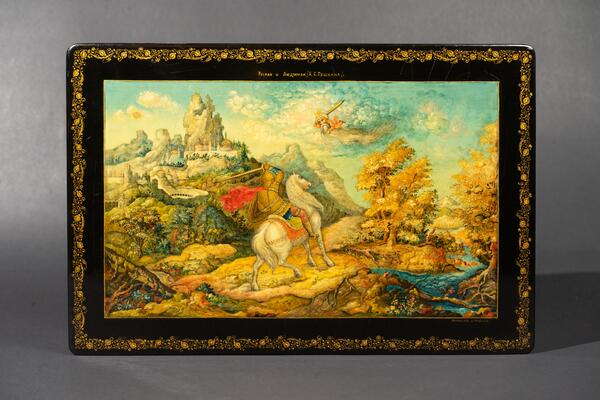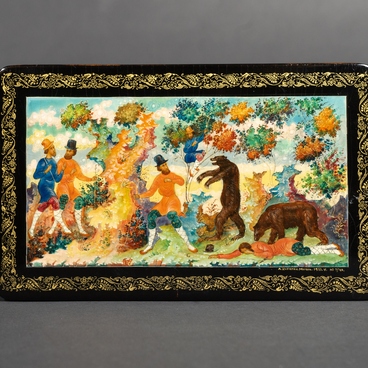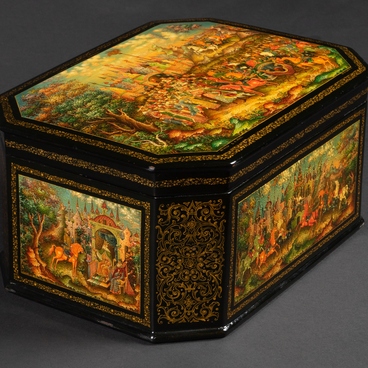Ivan Fomichev was one of the first-generation artists of Mstyora lacquer miniature school. As a high-class icon painter, after the revolutionary events of 1917, he was forced to abandon his beloved profession and worked for many years as an accountant and assistant accountant.
A memorable date helped the artist to return to painting — 100 years since the death of poet Alexander Pushkin, who died on January 29, 1837. Lacquer craftsmen were carefully preparing for this day. In 1937, Ivan Fomichev picked up his brush again and created his first work on a papier mâché object. According to various sources, the very first miniature of the author could be either ‘The Song of the Wise Oleg’ or ‘Ruslan and Ludmila’. His first experiments in lacquer miniature immediately demonstrated the artist’s extraordinary talent in a new field for him, and since 1937 the master never stopped creating miniatures. Most of his works were dedicated to fairy-tale and historical themes. In total, Ivan Fomichev managed to paint more than 500 miniatures.
The box “Ruslan and Ludmila” displayed in the museum is one of the author’s early works. The artist based it on the poem by Alexander Pushkin and chose the moment of Ruslan’s battle with sorcerer Chernomor, who kidnapped Ludmila. He built the composition by creating multiple planes, which echoes the principle of theatrical scenery: he placed the characters as if on a stage enclosed by landscape and architectural scenes-coulisses.
Skillfully using the effect of contrasts, the master draws the viewer’s attention to the foreground, where the dramatic action unfolds. At the same time, the background, enveloped in a shimmering bluish haze, looks peaceful and calm.
In this miniature, one can recognize the influence of Western European classical landscape — it is surprisingly combined with the icon painting style. The work shimmers with a soft, even light, in which flowers flash brightly among the greenery.
The master added soft shades of gray on top of the bright colors. Due to this technique, the work is distinguished by a characteristic silver-pearly tonality with many subtle nuances. The ornamental gold stripe along the edge of the box repeats the ochre color scheme of the landscape elements — the trees and hills. This artistic solution made the work cohesive and especially elegant.
A memorable date helped the artist to return to painting — 100 years since the death of poet Alexander Pushkin, who died on January 29, 1837. Lacquer craftsmen were carefully preparing for this day. In 1937, Ivan Fomichev picked up his brush again and created his first work on a papier mâché object. According to various sources, the very first miniature of the author could be either ‘The Song of the Wise Oleg’ or ‘Ruslan and Ludmila’. His first experiments in lacquer miniature immediately demonstrated the artist’s extraordinary talent in a new field for him, and since 1937 the master never stopped creating miniatures. Most of his works were dedicated to fairy-tale and historical themes. In total, Ivan Fomichev managed to paint more than 500 miniatures.
The box “Ruslan and Ludmila” displayed in the museum is one of the author’s early works. The artist based it on the poem by Alexander Pushkin and chose the moment of Ruslan’s battle with sorcerer Chernomor, who kidnapped Ludmila. He built the composition by creating multiple planes, which echoes the principle of theatrical scenery: he placed the characters as if on a stage enclosed by landscape and architectural scenes-coulisses.
Skillfully using the effect of contrasts, the master draws the viewer’s attention to the foreground, where the dramatic action unfolds. At the same time, the background, enveloped in a shimmering bluish haze, looks peaceful and calm.
In this miniature, one can recognize the influence of Western European classical landscape — it is surprisingly combined with the icon painting style. The work shimmers with a soft, even light, in which flowers flash brightly among the greenery.
The master added soft shades of gray on top of the bright colors. Due to this technique, the work is distinguished by a characteristic silver-pearly tonality with many subtle nuances. The ornamental gold stripe along the edge of the box repeats the ochre color scheme of the landscape elements — the trees and hills. This artistic solution made the work cohesive and especially elegant.



